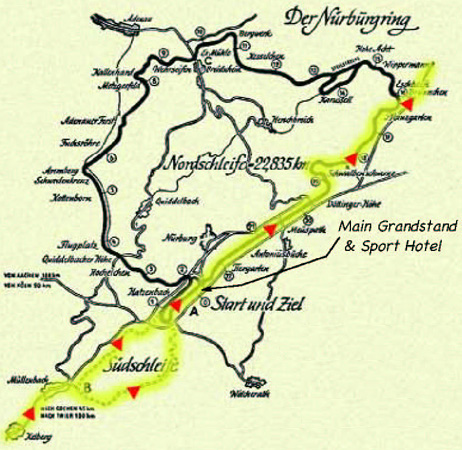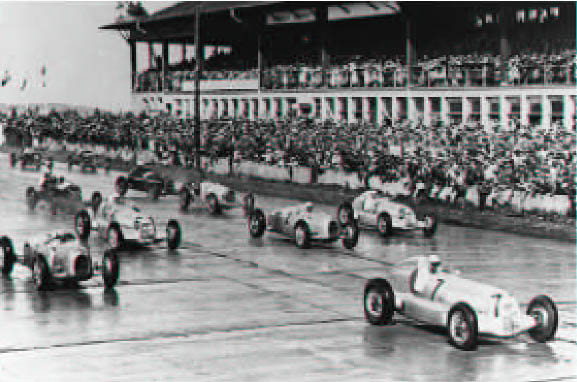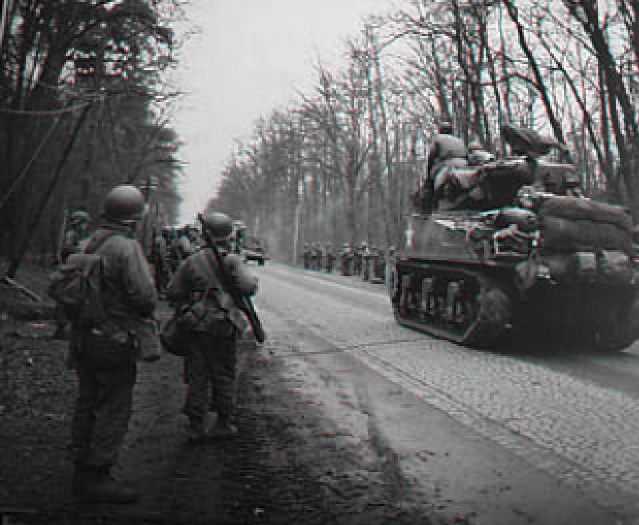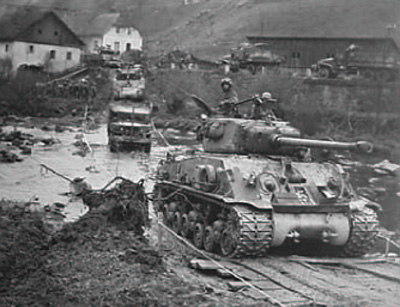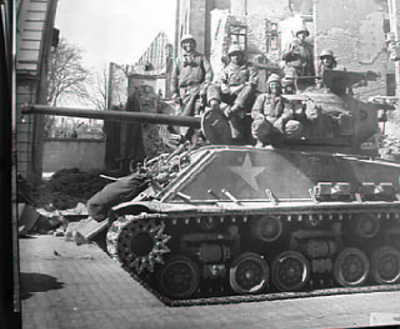|
Back
to "Our History" ROUNDEL • AUGUST 2005
When recounting the Allies’conquest of Western Europe during World War II, most historians say that General George S. Patton’s Third Army “raced” across the Continent. Perhaps no other soldiers in that famous group deserve that description more than the GIs of the 11th Armored Division—who swept by four of Europe’s legendary race tracks on their way to victory. Activated on August 15, 1942, at Camp Polk, Louisiana—now Fort Polk—the unit was nicknamed the Thunderbolt Division. They departed for Europe from Staten Island on September 29, 1944, aboard troopships that were part of the largest Atlantic convoy of the war, and landed in England two weeks later. After training on the Salisbury Plain in southern England, the Division deployed to the Continent in early December via Cherbourg, where its initial mission was to clear out the last vestiges of enemy activity in western France.
The Battle of the Bulge, the German’s surprise attack into Belgium that began on December 16, 1944, changed that plan. In response, the Thunderbolts began a grueling forced march on December 20, covering nearly 500 miles across France and Belgium. On December 21 the Division made a brief pit stop for maintenance, fuel, and supplies in Le Mans, site of the 24-hour sports-car endurance race, then skirted Reims, home of the Grand Prix de la Marne—and, on occasion, the French Grand Prix. The unit arrived in the area of the desperate battle on December 23 and played a crucial role opening a vital supply line to the besieged town of Bastogne. Three weeks later, the Division advanced to within tem miles of Spa-Francorchamps, the traditional venue of the Belgian Grand Prix. On February 13, 1945, the Thunderbolts mounted an attack to crack the defensive positions along the vaunted Siegfried Line on the Belgian-German frontier, a slow process because of stiff resistance. However, when the Thunderbolts crossed the Kyll River at Gerolstein, Germany (about twelve miles southwest of the Nürburgring) on March 7 as part of Operation Lumberjack, enemy defenses began crumbling so quickly that the unit was ordered to arrive on the western banks of the Rhine River the next day, a distance of some 40 miles. That assignment would have been impossible against any sort of organized defense. THE BATTLE OF THE BULGE, THE GERMAN’S SURPRISE ATTACK INTO BELGIUM THAT BEGAN ON DECEMBER 16, 1944, CHANGED THAT PLAN. IN RESPONSE, THE THUNDERBOLTS BEGAN A GRUELING FORCED MARCH ON DECEMBER 20, COVERING NEARLY 500 MILES ACROSS FRANCE AND BELGIUM. ON DECEMBER 21 THE DIVISION MADE A BRIEF PIT STOP FOR MAINTENANCE, FUEL, AND SUPPLIES IN LE MANS… Accordingly, the Division’s Combat Command B (CCB)—consisting of tanks, mechanized infantry, artillery, and supporting units—attacked to the northeast, roughly along present-day Highway B257, through the towns of Kelberg, Müllenbach, and Kempenich. Dead center on that route of advance was the Nürburgring. Despite the historical significance of this phase of the operation, there is surprisingly little information regarding what happened that day (and over the next two months) at the legendary track. However, unit after- action reports and a few popular accounts—some of them contradictory —enabled us to piece together some of the details. (In the case of conflicting information, precedence was given to official accounts.) At noon on March 8, in freezing rain and snow flurries, the CCB destroyed a self-propelled assault gun and two pillboxes, and took nearly 200 prisoners near Kelberg, a critical road junction on one of the highest ridges between the Kyll and Rhine River valleys. About three hours later, the Thunderbolts reached the village of Müllenbach on the southern tip of the Nürburgring. The track, constructed between 1925 and 1927, originally
included three distinct circuits that could be used individually In Müllenbach the lead battalion moved its M4 Sherman tanks onto the Südscheilfe using an access road adjacent to the main road through the village. Although we could not find any record regarding how many tanks the battalion had that day, considering the fact that it had been in combat for two months, it’s safe to say that the unit did not have its full complement of 76 tanks. Advancing north, some vehicles proceeded on the western side of the track in the race direction (clockwise) and others advanced on the eastern portion of the road… which would have been against racing traffic. Meeting at the northern part of the now-defunct circuit—today a portion of it leads to parking lots for the Grand Prix
track—they drove along the Start/Finish straightaway to the huge main grandstands and the Sport Hotel. There they
The battalion then advanced northeast on the Nordschleife—against the race direction—about four miles to
Pflantzgarten, ACCORDING TO FOLKLORE, TANKS SEVERELY DAMAGED PORTIONS OF THE SOUTH CIRCUIT—BUT THAT WOULD TAKE TIME-CONSUMING, DELIBERATE ACTIONS TO ACCOMPLISH, BECAUSE MERELY DRIVING TANKS ON A PAVED ROAD DOES NOT NECESSARILY CREATE “SEVERE” DAMAGE. THE THUNDERBOLT TANKERS HAD MORE PRESSING CONCERNS THAN RUINING A ROADWAY THAT UNITS FOLLOWING THEM COULD USE… Able and Baker Companies of the Division’s 133rd Ordinance Battalion paused at the Müllenbach and Muespath track entrances respectively until March 12, when they advanced through the town of Mayen on their way to the Rhine. Here’s where the story gets a little fuzzy. According to folklore, tanks severely damaged portions of the South Circuit—but that would take time-consuming, deliberate actions to accomplish, because merely driving tanks on a paved road does not necessarily create “severe” damage. The Thunderbolt tankers had more pressing concerns than ruining a roadway that units following them could use, especially since many of the public roads in the area were in poor shape from the heavy rains and, in many cases, were clogged with damaged and destroyed enemy vehicles. Some sections of the track were damaged, but exactly who did it and how it was done remains unclear. Curiously, no mention of damage to the North Circuit was included in any of the accounts despite the CCB driving on the four-mile stretch of the big track.
Over the next two months, an American unit (the designation of which was not given in any of our sources) used the Sport Hotel as a headquarters. Some of the buildings in the Start/Finish area were demolished (people from surrounding towns used the materials to repair their homes and businesses); at least one burned to the ground, and the hotel was ransacked. Two months to the day after capturing the Nürburgring, the Eleventh linked up with Soviet units at Amstetten, Austria. In four months and two weeks of combat, the Thunderbolts had moved through France, Belgium, Germany, a corner of Czechoslovakia, and Austria—in one of the most rapid advances in military history. After the war, French forces occupied the area west of the Rhine, including the Eifel region in which the Nürburgring is located. In 1946 they directed that repairs to the track and its facilities begin immediately. Seven years of neglect resulted in parts of the three circuits being blocked with weeds, shrubs, and poplar trees growing through the roadway. In some areas, large tree branches had grown together, forming a canopy over the track. More than 300 workers converged on the place, clearing and resurfacing sections of the track and the surrounding access roads.
The first post-war race, the Eifel Cup for motorcycles, was run on the Südschleife on August 17, 1947, in front of 80,000 spectators—who, for their $1.25 admission, received coupons for wine, bread, and sausages. The Sport Hotel reopened in April 1949, and a month later the Nordschleife hosted the first automobile race held there since 1939. The German Grand Prix returned to the Ring in 1950, a Formula 2 race won by Alberto Ascari in a Ferrari 166 F2/50. And Toni Ulman finished fourth in a Veritas RS Spezial—powered by a BMW 328 engine—one lap behind Ascari.
|
